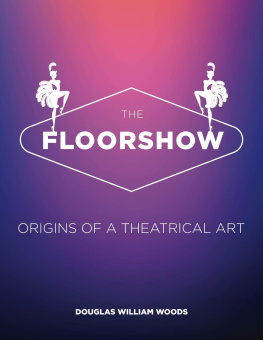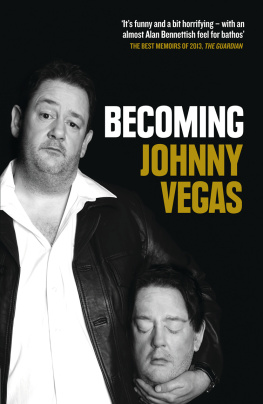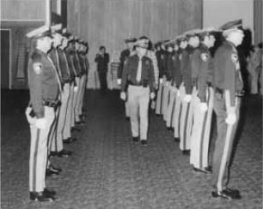The Floorshow:
origins of a theatrical art
DOUGLAS WILLIAM WOODS
2016
DOUGLAS WILLIAM WOODS
 ALL RIGHTS RESERVED
ALL RIGHTS RESERVED
DEDICATION
For My Dad and Mom,
Roy and Erna Woods,
and Lyn, Pam, and Roy
CONTENTS
Acknowledgments | i |
| INTRODUCTION EARLY HISTORY OF MASQUES | Page 1 |
| AN OVERVIEW OF THE STRUCTURE OF FLOORSHOWS | Page 24 |
| THE LAS VEGAS PRODUCTION OF A FLOORSHOW | Page 44 |
| THE FUTURE OF THE FLOORSHOWS | Page 93 |
| Bibliography | Page 99 |
Cover Design by Masa Homma |
ACKNOWLEDGMENTS
The University of Akron, School of Dance, Theatre, and Arts Administration:
James Slowiak, Durand Pope, Adel Migid, and Lisa Lazar
David Morgenstern, Shirley Morgenstern-Topilow, and Carl Topilow
Lido Colleague, Miranda Coe
Family and Friends,
Regine Mallath,
Masa and Pam Homma,
Archie and Diana Smith,
Jason Reddock
Career Transitions For Dancers; Joanne Devito, Linda Bunch, and Ann Barry
Ginny Poehling, and Lisa M. Jacob at the Las Vegas News Bureau.
Las Vegas Convention and Visitors Authority
Frederic Apcar Productions
David Strow, and Lynn Jax, Boyd Gaming Corporation
Gary Thompson, Caesars Entertainment
CHAPTER I
INTRODUCTION
The floorshow, commonly referred to as a musical revue, is a theatrical production with a large ensemble of lavishly costumed dancers and singers. From the late 1880s on, the Parisian cabaret influenced the evolution of the American musical revue, Hollywood movies, and other entertainment forms. On July 2, 1958, the Lido de Pariss Cest Magnifique established the floorshow as a theatrical art in Las Vegas. This thesis will explore the origins and history of the floorshow and its influence on other performing arts.
Early History of Masques
The floorshow is a theatrical art that depicts the cultural history of the past, where masques provided an interaction between the classes. Records from the later Renaissance period (14581550) indicate that the Italian court presented court theatre pieces known as intermezzi during lavish masques. These intermezz i introduced the processional-step for nobility and guests, and later to professional dancers in a show of steps and athletic routines. Though the intermezzi were an inter-act at the masques, they were usually dramatic pieces with music and dance that often lasted as long as the main acts. Several Italian dance masters of the period kept track of the practice hours required for learning the combinations of steps and for developing natural abilities. Guglielmo Ebreo da Pesaro was a dance master, choreographer, and author of De practica seu arte tripudii (On the Practice or Art of Dancing) , published in 1463 . Pesaro listed the important principles of dance and described five elements as the qualities necessary for dancers: posture, musicality, style, memory, and the ability to count. As he described it, the pavana (processional) step began on a whole count; there was also a faster variant, passo e mezzo (step-and-a-half). Pesaros defense of dancing as a noble art established rules and also required that some dancers perform with professional standards, which displayed their technique for presentation and entertainment.
The study of dance techniques unified the court artists. Masques often featured processional dance suites for couples, where the nobility and their guests could accompany and present a partner to augment their social status. The pavana is a slow and dignified dance, usually set to music, and has been compared to the modern day hesitation step used in weddings. In 1581, Fabritio Caroso wrote a book on dance called Il ballarino , which describes the selection of a dance partner and courtly etiquette and includes a detailed lesson to practice the combination of steps. Caroso indicated that partnering dances, such as the tarantella and the basse danse (low dance), could be attempted by anyone. Other dances were meant for people of particular social classes.
The basse danse was a courtly dance for couples that originated in the fourteenth century. Its name is attributed both to its possible origin as a peasant dance and its style of gliding steps in which the feet remain close to the ground. It was performed with various combinations of small bows and a series of walking steps completed by drawing the back foot up to the leading foot. The basse danse was typically followed by the stately pavana . Finally, the masque would conclude with an after-dance that featured a trained troupe of dancers who would entertain guests with a galliard , a combination of four hopping steps and one high leap that permitted the professional dancers to show off their virtuosity.
Catherine de Medici, Queen of France and mother of three French kings, provided her children and their courtiers with rigorous dance training. King Louis XIV, in particular, had a penchant for dance. In 1661, he established the first ballet academy in Paris. Teachers at the academy required dancers to take lessons and be trained in ballet daction , a technique developed by choreographer Jean George Noverre. Noverres technique produced athletic and artistic professionals who were honored with an appointment and monetary endowment from the French court.
Another book, cleric Thoinot Arbeaus Orchsographie (1589), has provided historians with information on ballroom behavior and the interaction between musicians and dancers. Arbeaus entire book was not translated into English until 1961 and is still the only known source for social dances of the time. It includes a male sword dance known as Les Bouffons , as well as the Morris Dance, a Northern Highlandstype folk dance. The tarantella is a couples dance that incorporates man-man and woman-woman partnering, with side-to-side steps, first in a chain and then in two opposing circles, like a wheel. It is characterized by a fast, upbeat tempo, usually 6/8 time (sometimes 4/4), and is accompanied by tambourines . These traditional dances provided a link between court dance and folk dance: elements of folk dance invigorated courtly dances and folk dances utilized movements from courtly dances. The choreography of each form infused the other and class division in dance became less apparent. The main difference between the two forms became less about steps and movements and more about style and elegance.
As early as the fifteenth century, the theatrical stage had been changing and developing to provide a suitable space for new production genres. According to costume historian Regine Mallath, the masques initiated the development of elaborate costume designs made of imported fabrics, exotic feathers, and fur. With the invention of moveable scenery, productions improved technically. King Louis XIV ordered the construction of a stage in the north wing of the Palace of Tuileries in Paris. This Salle de Machines housed a stage with overhead rigging that allowed actors in harnessincluding the King himselfto fly in productions based on Greek and Roman mythology. The masques assisted in unifying French culture and presenting the countrys ruler publicly in a worldly way. Court masques have been documented as the training ground for talented artists who were involved in singing, acting, and stage design. It is in the court masque that dancers first explored the theatrical art that became the floorshow.
Performing Ensembles in Post-Colonial America
One major component of the floorshow is the size of the cast, referred to as an ensemble. Large groups of performers in synchronized steps and harmonized songs were appealing to audiences, so dancers were seldom presented as soloists in the early incarnations of the floorshow in North America. Beginning in the eighteenth century, passengers and performers began traveling in crude wagons between the cities and towns of the American colonies, first within New England in 1744, then between New York and Philadelphia in 1756.
Next page








 ALL RIGHTS RESERVED
ALL RIGHTS RESERVED